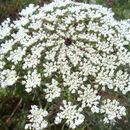Cyclicity
(
Inglês
)
fornecido por Plants of Tibet
Flowering from May to July.
- licença
- cc-by-nc
- direitos autorais
- Wen, Jun
Diagnostic Description
(
Inglês
)
fornecido por Plants of Tibet
Daucus carota var. carota is close relative of Daucus carota var. sativa, but differs from the latter in taproot slender, branched, woody, not fleshy, usually brown (vs. thickened, elongate terete or clavate, fleshy, reddish, reddish-yellow, or yellwo).
- licença
- cc-by-nc
- direitos autorais
- Wen, Jun
Distribution
(
Inglês
)
fornecido por Plants of Tibet
Daucus carota is occurring in Anhui, Guizhou, Hubei, Jiangsu, Jiangxi, Sichuan, Zhejiang of China, N Africa, SW Asia, Europe; cultivated and adventive worldwide in temperate regions.
- licença
- cc-by-nc
- direitos autorais
- Wen, Jun
Evolution
(
Inglês
)
fornecido por Plants of Tibet
The complete carrot plastid genome is 155,911 bp in length, with 115 unique genes and 21 duplicated genes within the IR. Phylogenetic analysis of nucleotide sequences for 61 protein-coding genes using both maximum parsimony (MP) and maximum likelihood (ML) were performed for 29 angiosperms. Phylogenies from both methods provide strong support for the monophyly of several major angiosperm clades, including monocots, eudicots, rosids, asterids, eurosids II, euasterids I, and euasterids II. Both MP and ML trees provide very strong support (100% bootstrap) for the sister relationship of Daucus with Panax in the euasterid II clade (Ruhlman et al., 2006).
- licença
- cc-by-nc
- direitos autorais
- Wen, Jun
General Description
(
Inglês
)
fornecido por Plants of Tibet
Plants to 120 cm. Leaves oblong, 2–3-pinnate/pinnatisect; ultimate segments linear to lanceolate, 2-15 mm long, 0.5-4 mm wide, glabrous to hispid especially on the veins and margins, acute, mucronate. Peduncles 10-55 cm, retrorsely hispid; bracts foliaceous, pinnate, rarely entire, lobes linear, 3–30 mm, margin scarious; rays 2-7.5 cm, unequal; bracteoles 5-7, linear, entire or 2-3-lobed, more or less scarious and ciliate, equaling or exceeding flowers. Petals white, sometimes yellow or pinkish. Fruit 3-4 mm long, ca. 2 mm wide.
- licença
- cc-by-nc
- direitos autorais
- Wen, Jun
Genetics
(
Inglês
)
fornecido por Plants of Tibet
The basic chromosomal number of Daucus carota is 2n = 18 (Das and mallick, 1985; Subramanian, 1986; Krishnappa and Basappa, 1988; Dobeš et al., 1997).
- licença
- cc-by-nc
- direitos autorais
- Wen, Jun
Habitat
(
Inglês
)
fornecido por Plants of Tibet
Growing in mountains slopes, ruderal areas, also widely cultivated; 2000-3000 m.
- licença
- cc-by-nc
- direitos autorais
- Wen, Jun
Uses
(
Inglês
)
fornecido por Plants of Tibet
The fruit of Daucus carota were used for medicine (“hu luo bo”) and oil.
- licença
- cc-by-nc
- direitos autorais
- Wen, Jun

